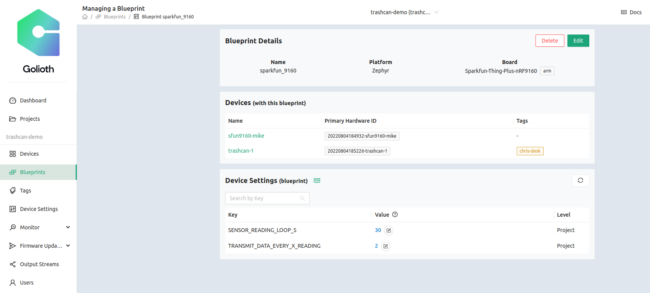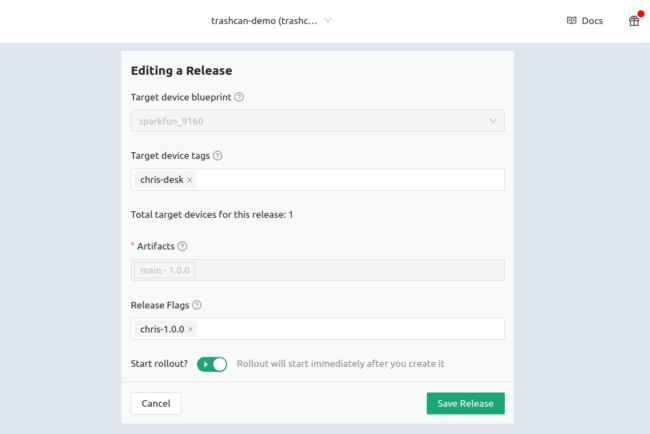Building IoT systems is always a push and pull to find the balance between designs that are very rigid in their definition (hard to change later) and overly generalized (less useful for everyday development). Golioth Blueprints are a new concept which apply structure to the relationship between the Cloud and the Device. Blueprints enable more useful features throughout the life of an IoT deployment. In this post we’re going to talk about what a Blueprint is, and how it is used throughout Golioth to enhance capabilities for our users.
Flexibility is a blessing and curse
Golioth works on a wide range of hardware. That’s the blessing. We think it’s really important to meet hardware and firmware teams where they are. If a client requirement or a sourcing issue pushes you into a particular chipset + communication method, we want to support you. That’s why we have multiple SDKs, each of which can pull in a wide range of parts.
But when you “can do anything”, that means nothing is standardized. Data coming in from a temperature sensor is treated the same as data coming in from a motor controller. Firmware updates being deployed to a device in the field running on a Cortex-M7 can also be pushed to a device running on a Cortex-M0 (hardware tip: these are very different). So the curse is that the exercise of separating and protecting all of that data is left up to you. Your Cloud team might only want a piece of data or a variable, but the implications of a mistake in your data design could be severe for your very real hardware deployment.
As you’ll see below, Blueprints will help bridge the communication between the embedded team and the Cloud team. They add information that would normally be hidden somewhere, maybe in a hardware datasheet or an engineering team specification document. Like real blueprints, Golioth Blueprints help to map out how things should be built.
Why are Blueprints needed?
To put an even finer point on the topic of Blueprints, let’s discuss a real-world example. Imagine an environmental monitoring product that has the following in its Rev A version of hardware:
- nRF9160 cellular SIP from Nordic Semiconductor (running dual Cortex-M33 processors)
- BMP280 temperature/environmental sensor
- 4 MB external SPI flash
- Other supporting components
Due to sourcing issues, you can no longer get any of these parts. Yep, it’s that bad out there. Your Rev B (because you need to ship something to your customers) now has:
- An nRF52840 processor (single core Cortex-M4)
- A BG95 cellular modem
- BMP680 environmental sensor
- 8 MB of external SPI flash
In the Golioth NCS SDK, the coding differences are minimal, despite pretty extreme changes in the hardware. However, thanks to how Zephyr RTOS is set up, it will be a set of configuration files instead of completely rewriting the codebase.
This is standard fare during the chip shortage, which we wrote about last week. Some companies are taking extreme steps like this in order to continue shipping their products, basically supporting two divergent product lines that can achieve the same goals. The key point is that the software team/end customer/consumer of the data via your company’s app probably doesn’t care how the data gets from the physical world to the digital world, they just want the variables they’re looking at (ie. temperature) to be accurate.
Now that we have pretty different Rev A and Rev B boards, how do we keep everything straight when we’re maintaining these products?
Enter the Golioth Blueprint

The Golioth Blueprint is a description of all of the relevant things on target devices. As the Blueprint continues to mature in the coming months and years, we will evolve the types of data stored in the Blueprint. For now, we lean on board definitions that are in Zephyr. For the above screenshot, you can see that we are using the Sparkfun Thing Plus nRF9160 (based on the CircuitDojo nRF9160 Feather), which is indexed on the Zephyr website and in the Zephyr/NCS codebase.
From the meta data provided by Zephyr, we can pull in things like the target chipset, memory amount, how it’s mapped, peripherals that are available, and even external sensors that are on board (an accelerometer). If you have your own board definition upstream in Zephyr, you would also see that in the Golioth Blueprint list. We are working on other ways to pull in formatted metadata around customized boards that might need to stay private. If you’re interested in that, please email us.
If you don’t have a Blueprint, say because you’re using our ESP-IDF SDK instead of Zephyr, or a completely different platform, that’s OK too. You can assign a placeholder Blueprint name to help delineate between your different hardware builds. Generally, you are not required to use a Blueprint when you are on the Golioth Console, but there are many benefits to doing so. Let’s look at some.
Over-the-Air Firmware Update
Golioth users can assign a Blueprint to their firmware updates:
Doing so means that the Firmware Release will only target a specific subset of devices. If we go back to the example above, this could be critical when the target devices have completely different processors on board; firmware built for an nRF9160 will not work on an nRF52840! Attaching a Blueprint, even without attaching additional meta information (from Zephyr board files) still allows you to track which devices are receiving updates. Memory structure information will be used for future releases, being able to target different artifacts to different segments of memory.
Settings
Our recently released Settings service uses Blueprints to deliver different settings to different devices. As a reminder, settings can apply on the following levels:
- Project
- Blueprint
- Individual device
To use our example from above, you might want to have different setting when different sensors attached to your device. You could set something like “UPDATE RATE” for the project to be every 30 seconds, but maybe you want to have the Rev A boards report in twice as often because you want to average the readings on the Cloud.
If you click into a Device Management page (looking at a specific device), you will see how the settings are being applied by Project, Blueprint, or on that specific device.
Future plans for structured data
We are currently very flexible on the sensor data you are sending back over LightDB State and LightDB Stream. In the future, we hope to be able to extract sensor data from your Blueprint to have our Cloud intuitively understand the types of data that is received from your fleet. Users will benefit from being able to chart data and export to other platforms knowing that a reading is a temperature or another fixed type of reading.
Using Blueprints effectively for your next project
Golioth Blueprints are an enhancement that allows our users to keep track of the hardware they are communicating with in the field. As users’ fleets and number of SKUs grow, this will be a critical aspect to any device management platform.
Try out Golioth Blueprints today on the Golioth Console. If you need any help or would like to discuss the idea more, we have a forum, a Discord, and we can be reached at [email protected].




No comments yet! Start the discussion at forum.golioth.io